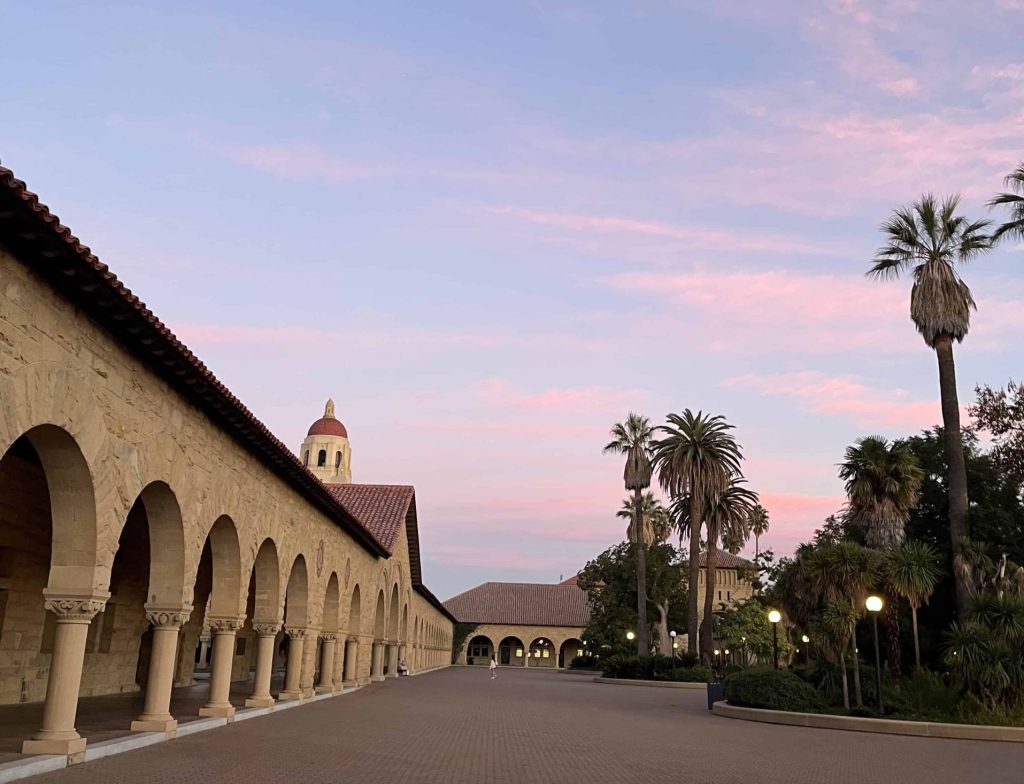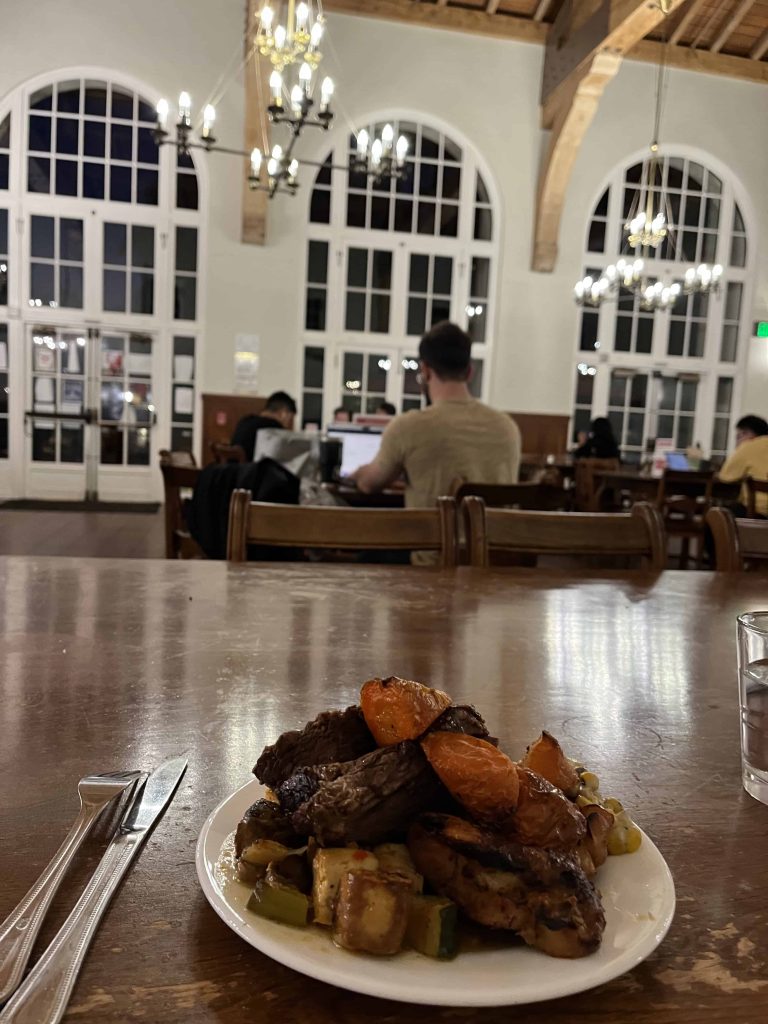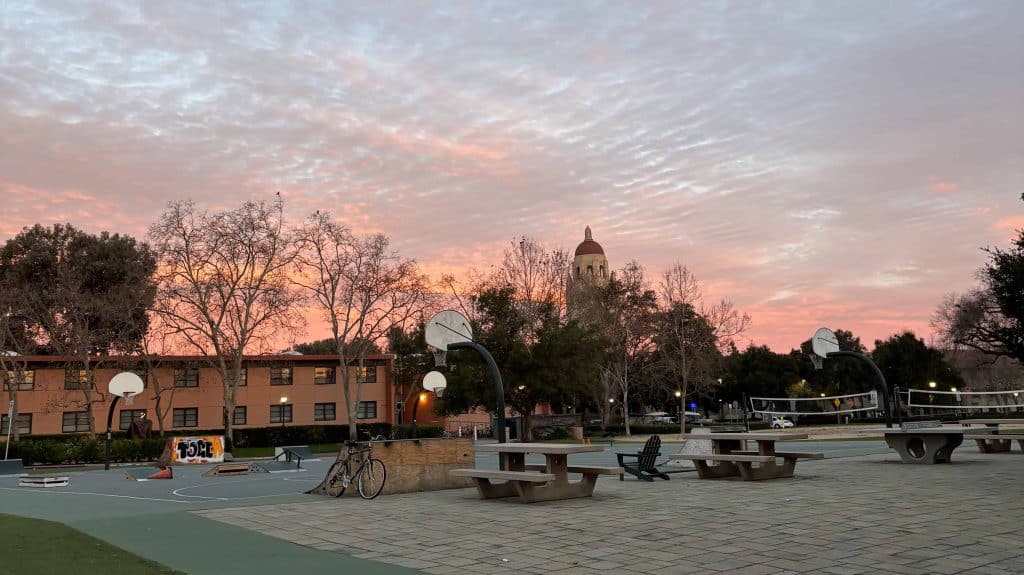I’ve officially finished my first quarter at Stanford! While I didn’t really know what to expect coming in, there’s been so much more than I ever imagined. From late-night cake decorating at the dorm to making friends through office hours to ice skating trips, I’ve had an incredible experience during my first quarter studying Computational Biology at Stanford. In honor of college decisions for current high school seniors coming out in March, I decided to give a review of my favorite and least favorite parts of being at Stanford, starting out with the best parts of being at Stanford!
Best:
The Community and the “Nerd Nation”
I know, it’s the most generic answer ever – the people. But it’s true. My favorite part of Stanford has been the friends and the people that I’ve met here, and I’m truly so grateful to be a part of this community. But in particular, the community is quite different from what I came in expecting, and here’s what I mean.
I actually came in expecting Stanford to be a toxic, pressure-cooker environment. But, it’s actually very different from that. I’ve found the environment to be incredibly supportive and accepting, and it’s one of my favorite communities that I’ve been in. First of all, there’s definitely an incredible caliber of people here. You will meet people who are insanely intelligent, people who have great ideas, people who will go on to do amazing things. People also work very hard here, so it’s not like everyone is just a natural genius. It’s a pretty inspiring environment to be around. As I’ve mentioned before, Stanford is definitely a “Nerd Nation,” where geeking out is cool. And that’s what I love, which is meeting people who are genuinely passionate about what they do. I’ve also found people to be generally kinder and more generous than average, at least compared to other groups and communities I’ve been around in the past.
In addition, I’ve found that most people are incredibly supportive and helpful. I’ve had random classmates I met during office hours dedicate hours after class to explain concepts to me, friends in my dorm who have helped me on all sorts of things, and friends who go out of their way to help out someone in need. I truly trust my friends here to be here for me and for me to be there for others, so it’s really nice to have a community that I genuinely feel supported and accepted. I found a big part of my community through my dorm, but people find their social circles through all sorts of avenues, including parties, clubs, and classes.
Of course, this depends HUGELY on personal experience, so I definitely can’t speak for everyone. It’s definitely not perfect either. One of the worst mistakes people make when going into college is expecting college to be perfect and to solve all of their problems. You will meet people you don’t like, and you will meet people who emulate the toxic and competitive aspect of the Bay Area culture. But, you can’t let that define your experience of college, and at Stanford, there’s such an incredible collection of people that I believe it’s very possible to find a group that you enjoy.

The Unique World-Class Opportunities
When I was choosing colleges, I thought all of the universities seemed pretty similar to me in their “world-class” opportunities. I knew Stanford was technically ranked highest out of a lot of other schools, but it didn’t seem like that big of a difference to me. However, I’ve realized that Stanford truly has world-class faculty – and it makes a difference. From learning from the best-of-the-best, it has been a very eye-opening experience. For example, at my current lab, I’ve noticed lots of things about the practices and environment that shape the lab culture, and from that, I definitely can tell why they produce good science. As an aspiring scientist, I think these experiences are incredibly valuable in shaping how I work and approach problems, as it’s an opportunity to be trained by some of the top people in the world.
However, Stanford’s position on world-class opportunities definitely relies on you to be a self-starter and take advantage of it yourself. They offer the resources and the opportunities, but it’ll be up to you to take it and know what you want to do. There’s no one to hold your hand and guide you step-by-step, so it’s pretty much like everything is open for you to take, you just have to be the one to take the first step to take it. In fact, there’s not as much academic advising as I was initially expecting. The academic advising I’ve received here is pretty much comparable, if not less, than high school. To me, it’s not that big of a deal since I’m okay with the independence, but you do have to learn to figure things out for yourself.
Classes – A Mix of Independent Learning and Support
I always wondered whether the academics at Stanford would truly be worth the reputation, as ultimately, classes are a big aspect of college. My verdict is that classes actually make up much less of the college experience than I expected. However, I’m actually pretty happy with the classes and academics here. Firstly, if you’re looking for one-on-one support, individualized hands-on classes, Stanford won’t really give you that. Especially in introductory classes, you won’t really get small class sizes and individualized attention just from showing up to class.
I’ve found most of my classes to be interesting and enjoyable, and the less individualized approach works out well for me, as I get to choose which classes I spend a lot of time and focus on. Stanford offers lots of office hours and tutoring, so I can always go get tutoring if I have questions. That wasn’t usually available for me in high school. I think I tend to enjoy classes more when I have to work hard to figure it out rather than just having someone guide me through the whole process, so I like having this relatively independent, but also supported, approach to classes.
One thing I’ve learned about taking classes here is that just going to lecture often doesn’t provide all the information you need, and it’s perfectly fine to ask for help at office hours. The lectures are often just to introduce the topic, and much of the actual content and problem-solving comes from office hours, homework, and sections. I used to feel bad if I couldn’t solve a problem on my own, but now I’ve realized that sometimes, there was truly no way for me to have known how to solve it without having seen something similar before, so it’s perfectly fine to ask for help and guidance. With all the resources that are offered, it’s a good thing to take advantage of all of the resources to aid your learning.

Decent Housing and Accommodations
This is actually not one of my major likes or dislikes about Stanford, but I just wanted to address this for anyone curious about how the food and housing is at Stanford. In my opinion, it’s decent and servicable. There’s a lack of options regarding food and housing. Stanford boasts that 98% of undergraduates live on-campus, and that’s because any housing off-campus would be too far and overpriced for anyone to be able to reasonably live off-campus. Even graduate students, professors, and staff members often live on campus. However, the dorms are decent. It’s a typical college dorm – nothing too fancy, but it works. Most of the rooms for underclassmen are either one or two room doubles. We also have communal bathrooms for the whole floor, which is typically around 7-10 people. The dorms also have a kitchenette and a lounge, although the kitchenette gets quite gross sometimes. We have a cleaning staff that keeps everything clean and running.
As for food, we have nine dining halls around campus, mostly clustered around East Campus. You can go to any of the dining halls that you want, although they generally serve the same food with a few specials here and there. The food is pretty good, and my friends at other schools have definitely attested to this, as it’s currently ranked in the top half of the top five schools in our rating list. My only complaints would be the lack of options if you aren’t able to eat at the dining hall for some reason. Because dining halls are only open at certain times, it can be quite inconvenient if you have an earlier or later class that clashes with the dining hall schedule. Your options outside of the dining halls are quite limited, as there are only a few cafes and restaurants on campus that are mostly to-go, and two very overpriced marketplaces on campus. In general, food has not been a huge issue, and not something that I would say is a particular positive or negative about Stanford.
Worst:

The Campus
I know, I know, if you’re on my blog, you’ve probably realized that my top complaint is always about the campus. Which, honestly, is not that bad if my primary complaint is just about the campus. However, here are the specifics of what I don’t like about Stanford’s campus.
The “Stanford Bubble”
Stanford is known for the “Stanford Bubble,” and it’s definitely real. In my first few weeks at Stanford, I said it felt like living in a hamster cage, where I technically had everything I needed to live, but it just seemed very enclosed from the outside world. It’s a 40 minute walk off-campus, so you likely won’t be going off-campus very much, especially as there’s very little public transportation. If there’s nothing to do on campus, you’re pretty much stuck. Either you take three hours commuting into San Francisco or San Jose, or you just sit around doing nothing on campus. Palo Alto is also quite boring in my opinion, as most of the shops are extremely expensive or overpriced, and not meant for the college student budget. In fact, if you search up places to visit in Palo Alto, most of the results direct you back to Stanford’s campus.
More specific to the campus itself, there are lots of buildings that were clearly not designed for functionality. For example, there’s a research building with lots of explosive and dangerous lab equipment that was designed with entirely glass walls and windows. Aesthetic? Yes. Functional? No. Oversights like these just seem ridiculous why the problem even exists. The campus is also extremely large and sprawled out, so my science classes are about a mile from my dorm. Because of this, there’s a huge biking culture on campus, and if you don’t love biking, you’re going to be spending a lot of time either grimacing against the wind or walking several miles a day. In addition, there’s also a very limited number of places to go to on campus. We don’t have many restaurants and cafes on campus, so it’s not like your options are extensive for food outside of the dining hall. If you’re missing things like daily essentials, either you pay $12.00 for a one-subject spiral notebook at the Stanford bookstore or spend two hours commuting off-campus to a local Target. I once wanted some Greek yogurt and found out that it would cost $18.00 total to get a container of yogurt delivered to my dorm. So, your options for getting anything overall are very limited.
Finally, other small issues include the lack of proper study spaces and spots for Zoom calls. For some reason, we don’t really have great study spots on campus. Lots of buildings have places where you can sit down and do work, but if you’re looking for a cute, aesthetic coffee shop to do work in, you won’t find it at Tresidder. We don’t have many study rooms on campus, and the ones at the library are often booked out.
The Administration
I never understood what it meant for a university’s administration to be good or bad, but unfortunately, I have now experienced what a bad administration means. Firstly, the bureaucracy is quite bloated at Stanford. Sometimes you will have to jump through hoop after hoop to get something done, especially regarding paperwork. I once had an enrollment hold that I needed to get lifted, and I had to run around between Student Services and Financial Aid multiple times to get either of them to communicate. From mislabeling scholarship checks to class enrollment issues, you would expect these processes to be more efficient at a school like Stanford, but unfortunately, it’s not. It’s incredibly frustrating and annoying, especially when it takes a large part of your day to resolve a very small issue.
I won’t speak too much about the other, more serious issues that the Stanford administration has been criticized for, since you can find the news and commentary about it online. But even in regards to issues in my daily life, the administration is very bureaucratic and can be quite frustrating to deal with.
Stanford Flake Culture and “Stanford Time”
One of the most prevalent stereotypes about Stanford culture is duck syndrome and flake culture, to the point where we even had a whole event about duck syndrome during new student orientation! As a student now, I have to say, the stereotype is true. But, as someone who came in really worried that I would greatly dislike this part of the culture, I have to say, it’s not as big of a deal as I expected, and moreso a slight annoyance.
So, what do I mean by flake culture and “Stanford Time”? Firstly, as part of the West Coast “laid-back” culture, people are very, very often late here. If you say an event goes from 5-8 PM, you can expect people to only start showing up at 6 PM at the earliest. If you say you’re meeting someone at 5 PM, expect them to be at least 10-15 minutes late. This was a huge annoyance to me, because as someone who likes to be punctual, it was a huge shock to me how pretty much nothing is ever on time here. From Caltrain departures to meeting times, “Stanford time” means people rarely ever show up when they say they will.
Flake culture is also very real. It’s mostly evident in the clubs and club participation, where only a few people will show up to club meetings. It’s also common when making plans with people, where people will often cancel or show up late. However, on the other side of this is the relative lack of competitive club culture compared to schools like Yale and Harvard. In comparison to Harvard and Yale, the clubs at Stanford aren’t that selective. There are some clubs at Yale that are harder to get into than Yale itself, and Stanford doesn’t have much of that besides a select few clubs and programs. As a result of that, there is less emphasis on club participation, and people will tend to be very flakey when it comes to actually showing up to things. It’s definitely annoying, but I wouldn’t say it has been detrimental enough to impact my overall opinion on my experience at Stanford.
Is Stanford Worth It?
So, one question I’ve always wanted to know is, is the hype of top schools worth it? To my surprise, I think I’ve gained a greater appreciation for going to a school like Stanford. It’s not perfect by any means, but the world-class opportunities and the amazing people I’ve met here have made it worth it, in my opinion. There are unique opportunities as a part of being at Stanford, and ultimately, I’m really grateful for the opportunity to be here.



